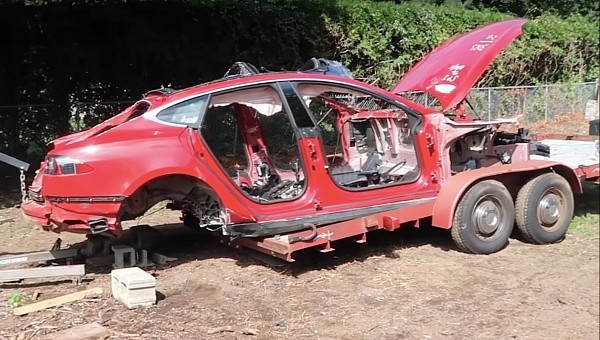Tesla disabled access to the Supercharger network for salvaged Tesla vehicles, justifying the move by the potential battery flaws in damaged cars. The EV maker has reconsidered its position, but there are conditions.
Many small companies and individuals thrive by buying salvaged vehicles and repairing them. Those trying to do the same with Tesla vehicles were dealt a blow in 2020 when Tesla blocked access to Superchargers (and even third-party fast charging) to all salvaged cars. Not only that, Tesla also refused to update ownership records or activate the smartphone applications, according to Teslarati. The app is mandatory to use certain functions.
Tesla claimed it denied fast charging to salvaged vehicles for safety reasons because the crash might have compromised the battery or other components. Of course, this doesn’t explain the more drastic measures, like refusing to update ownership records. As you can imagine, without fast charging access and crippled functionality, salvaged Teslas were no longer attractive to repair and sell.
The good news is that Tesla had a change of heart and will allow salvaged vehicles to gain access to the Supercharger network. But this comes with strings attached, as Tesla’s internal documents obtained by Electrek show. According to these, Tesla is establishing a new procedure that involves inspecting the high-voltage battery pack and all the components related to charging.
The salvaged vehicles would need to pass two inspections: the Salvage-Titled Vehicle High Voltage Safety Inspection and the Salvage-Titled Vehicle Fast-Charging Safety Inspection. If components fail to pass the verifications, Tesla will diagnose and repair them at the customer’s expense. Fast charging will not be enabled if the customer declines to authorize the required repairs.
Once a salvaged vehicle passes the inspections, it will be allowed to fast charge on the Supercharger network. Moreover, if the fast charging is enabled, but later the car fails the final charging test, the Supercharger access would not be disabled, even if the customer declines further diagnosis or repairs. At this point, the car is treated like any other Tesla, facing no limitations. The new validation process is currently rolled out to all Tesla vehicles.
The new policy is a boon for people repairing and selling salvaged vehicles. Bear in mind that not all cars that end up with a salvage title are destroyed. Sometimes an insurance company might consider it totaled, even for modest damages. Of course, if Tesla’s official repairs are expensive, reselling salvaged Teslas will still be impractical.
Tesla claimed it denied fast charging to salvaged vehicles for safety reasons because the crash might have compromised the battery or other components. Of course, this doesn’t explain the more drastic measures, like refusing to update ownership records. As you can imagine, without fast charging access and crippled functionality, salvaged Teslas were no longer attractive to repair and sell.
The good news is that Tesla had a change of heart and will allow salvaged vehicles to gain access to the Supercharger network. But this comes with strings attached, as Tesla’s internal documents obtained by Electrek show. According to these, Tesla is establishing a new procedure that involves inspecting the high-voltage battery pack and all the components related to charging.
The salvaged vehicles would need to pass two inspections: the Salvage-Titled Vehicle High Voltage Safety Inspection and the Salvage-Titled Vehicle Fast-Charging Safety Inspection. If components fail to pass the verifications, Tesla will diagnose and repair them at the customer’s expense. Fast charging will not be enabled if the customer declines to authorize the required repairs.
Once a salvaged vehicle passes the inspections, it will be allowed to fast charge on the Supercharger network. Moreover, if the fast charging is enabled, but later the car fails the final charging test, the Supercharger access would not be disabled, even if the customer declines further diagnosis or repairs. At this point, the car is treated like any other Tesla, facing no limitations. The new validation process is currently rolled out to all Tesla vehicles.
The new policy is a boon for people repairing and selling salvaged vehicles. Bear in mind that not all cars that end up with a salvage title are destroyed. Sometimes an insurance company might consider it totaled, even for modest damages. Of course, if Tesla’s official repairs are expensive, reselling salvaged Teslas will still be impractical.






